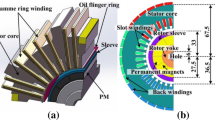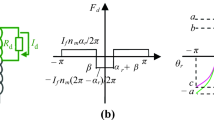Abstract
To research the variation characteristics and influence factors of air gap magnetic field and electromagnetic torque of nuclear power half-speed turbine generator with stator winding inter-turn short circuit, the two-dimensional transient electromagnetic field of generator-external circuit-grid coupling mathematical model is established by field-circuit-network coupling method. Taking the national laboratory’s generator as an example, and comparing the simulation results of the inter-turn short circuit of the armature winding with experimental data, the correctness of the model is validated. On this basis, the simulation model of a 1407MVA nuclear power half-speed turbine generator is built. Then the stator winding inter-turn short circuit fault is simulated when the generator is connected to the grid with rated load. The characteristics of air gap flux density and electromagnetic torque are obtained before and after fault, as well as, the relationship between their each component and the fault degree is obtained. At the same time, the variation law of air gap flux density and electromagnetic torque is obtained when the relative position between fault winding and magnetic pole changes. The theoretical reference for fault diagnosis and localization using harmonic electromagnetic torque after fault is provided.















Similar content being viewed by others
References
Meng L, Luo YL, Liu XF, Yang JF, Chi YB (2005) A case study of electromagnetic force distribution on rotor core surface of turbo-generator. Proc CSEE 25:81–86
He YL, Wang FL, Tang GJ, Jiang HC, Yuan XH (2017) Effect of stator inter-turn short circuit position on electromagnetic torque of generator with consideration of air-gap eccentricity. Trans China Electrotech Soc 32:11–19
Sarikhani A, Mohammed OA (2013) Inter-turn fault detection in PM synchronous machines by physics-based back electromotive force estimation. IEEE Trans Industr Electron 60:3472–3484
Wan ST, Wu WJ, He YL, Li H (2009) Analysis on vibration characteristic when eccentric vibration under stator winding inter-turn short circuit fault. J North China Electric Power Univ 36:86–93
He YL, Wang FL, Tang GJ, Jiang HC, Yuan XH (2017) Effect of stator inter-turn short circuit position on stator vibration of generator. J Vib Eng 30:679–687
Xie Y, Liu HD, Li F, Liu HS (2017) Effect of rotor eccentricity and stator short circuit faults on magnetic field and electromagnetic vibration characteristics of synchronous generator. J Cent South Univ (Sci Technol) 48:2034–2043
Wan ST, Li HM, Xu ZF, Li YG (2004) Analysis of generator vibration characteristic on stator winding inter-turn short circuit fault. Proc CSEE 24:157–161
Sun YG, Yu XW, Wei K, Huang ZG, Wang XH (2014) A new type of search coil for detecting inter-turn faults in synchronous machines. Proc CSEE 34:917–924
Zhao HS, Ge BJ, Tao DJ, Yang K, Xing G (2018) Investigation on stator winding inter-turns short circuit fault diagnosis. J Harbin Univ Sci Technol 23:99–104
Xiao SY, Ge BJ, Tao DJ, Liu ZH (2018) Calculation of rotor dynamic electromagnetic force of synchronous generator under the stator winding interturn short circuit fault. Trans China Electrotech Soc 33:2956–2962
Ye ZJ, You BQ, Rosendahl J, Kuling ST (2013) Fault characteristic study based on FLUX 2D for large synchronous generators with stator winding inter-turn short circuits under rated operating conditions. Proc CSEE 33:125–132
Fang HW, Xia CL, Xiu J (2007) Analysis of generator eletro-magnetic torque on armature winding inter-turn short circuit fault. Proc CSEE 27:83–87
Fang HW, Xia CL, Li GP (2009) Analysis of synchronous generator electro-magnetic torque and vibration with armature winding fault. J Tianjin Univ 42:322–326
Zhao HS, Ge BJ, Tao DJ, Han JC, Wang LK (2018) Influence of stator internal short-circuit fault on rotor eddy current losses in nuclear power turbo-generator. Electric Machines and Control 22:17–25
Hu MQ, Huang XL (2003) Numerical calculation method of motor performance and its application. Southeast University Press, Nanjing, pp 173–179
Hu J, Luo YL, Liu XF et al (2009) Influence of calculation parameters of time-stepping finite element method on simulation results in turbo-generators large disturbance process. Proc CSEE 29:59–66
Funding
National Natural Science Foundation of China (51407050).
Author information
Authors and Affiliations
Corresponding author
Additional information
Publisher's Note
Springer Nature remains neutral with regard to jurisdictional claims in published maps and institutional affiliations.
Rights and permissions
About this article
Cite this article
Xin, P., Ge, B., Tao, D. et al. Electromagnetic Torque Characteristics Analysis of Nuclear Half-Speed Turbine Generator with Stator Winding Inter-Turn Short Circuit Fault. J. Electr. Eng. Technol. 16, 2055–2063 (2021). https://doi.org/10.1007/s42835-021-00723-7
Received:
Revised:
Accepted:
Published:
Issue Date:
DOI: https://doi.org/10.1007/s42835-021-00723-7




